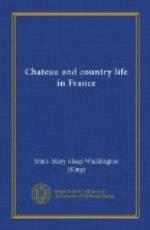We had a pleasant evening with music and “baraque”—which is not very fatiguing as a mental exercise. I tried to send all the party to bed early, and have come upstairs myself, but I still hear the click of the billiard balls, and sounds of merriment downstairs. It is a splendid starlight night, the sky quite blue over the pines. I think we shall have beautiful weather for our fete. I have very vague ideas as to how many people we shall have for breakfast and dinner to-morrow, but the “office” is warned. I hope we shan’t starve.
April 24th. Monday.
We had a beautiful and most successful day yesterday. All the household was stirring fairly early, as we had to get ourselves in to La Ferte before 12 o’clock. We started in all sorts of conveyances—train, carriage, voiturette—and found the Grande Rue full of people. The official breakfast was over, also the visit to the Mairie, where there are a few souvenirs of the poet—his picture, acte de naissance,[12] and signature. The procession was just forming to climb up the steep, little street that leads to the church, so we took a short cut (still steeper), and waited outside the doors to see them arrive. It was a pretty sight to see the cortege wind up the path—the Bishop of Soissons and several other ecclesiastics in their robes, blackcoated officials, some uniforms—the whole escorted by groups of children running alongside, and a fair sprinkling of women in light dresses, with flowers on their hats, making patches of colour. The church was crowded—one didn’t remark the absence of certain “esprits forts” who gloried in remaining outside—and the service was most interesting. The lecture or rather “Eloge de Racine” was beautifully given by the Abbe Vignot. It was not very easy for a priest to pronounce from the pulpit an eulogium on the poet and dramatic author who had strayed so far from the paths of grace and the early teachings of Port Royal, where the “petit Racine” had been looked upon as a model pupil destined to rise high in the ecclesiastical world; but the orator made us see through the sombre tragedies of Phedre, Britannicus and others the fine nature of the poet, who understood so humanly the passions that tempt and warp the soul, and showed a spirit of tolerance very remarkable in those days. He dwelt less upon the courtier; spoke more of the Christian of his last days. He certainly lent to the “charm of the poet, the beauty of his voice,” for it was impossible to hear anything more perfect than the intonation and diction of the speaker.
[12] Birth certificate.
There was a short address from Monseigneur Deramecourt, Bishop of Soissons—a stately figure seated on the Episcopal throne in the chancel. The music was quite beautiful. We had the famous “Chanteurs de St. Gervais,” and part of the chaeurs d’Esther, composed by Moreau, and sung in splendid style by Mme. Jeanne Maunay, M. Vincent d’Indy accompanying on the organ. The simple sixteenth century chaunts sung by the St. Gervais choir sounded splendidly in the fine old cathedral. The tones seemed fuller and richer than in their Paris church.




